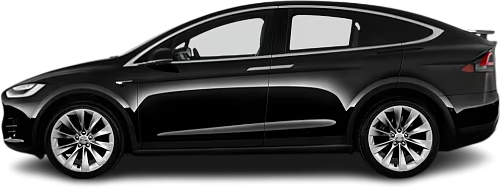Tesla Model X 75D vs BMW i7 eDrive50
Struggling to Decide? Let AI Help!
Your AI Summary Is Ready!
General Info
The BMW i7 eDrive50 (2023-…) is currently produced, it has a starting price of €115700. The Tesla Model X 75D (2016-2019) has been discontinued. You can find it for as low as €30500 on the used car market.
The Tesla Model X 75D (2016-2019) is a SUV, whereas the BMW i7 eDrive50 (2023-…) is a Sedan.
| Property | Tesla Model X 75D | BMW i7 eDrive50 |
|---|---|---|
| Years of Production | 2016-2019 | 2023-… |
| Current Status | Discontinued | Produced |
| Country of Manufacture | Netherlands, USA | Germany |
| Body Style | SUV | Sedan |
| Market Availability | EU, USA | EU, USA |
| Price Europe (New) | - Price Europe (New) | €115700 |
| Price Europe (Used) | €30500 | €88950 |
| GCC Score | 6.8 | 6.7 |
Range and Efficiency
The BMW i7 eDrive50 (2023-…) boasts a greater real-world range, a larger battery, and superior energy efficiency compared to the Tesla Model X 75D (2016-2019).
| Property | Tesla Model X 75D | BMW i7 eDrive50 |
|---|---|---|
| Range (EPA) | 383 km | 517 km |
| Range (WLTP) | - Range (WLTP) | 611 km |
| Range (GCC) | 338 km | 509 km |
| Battery Capacity (Nominal) | 75 kWh | 105.7 kWh |
| Battery Capacity (Usable) | 72.5 kWh | 101.7 kWh |
| Efficiency per 100 km | 21.4 kWh/100 km | 20 kWh/100 km |
| Efficiency per kWh | 4.66 km/kWh | 5 km/kWh |
| Range and Efficiency Score | 5 | 7.7 |
Charging
Both vehicles utilize a standard 400-volt architecture.
The BMW i7 eDrive50 (2023-…) offers faster charging speeds at DC stations, reaching up to 200 kW, while the Tesla Model X 75D (2016-2019) maxes out at 120 kW.
The Tesla Model X 75D (2016-2019) features a more powerful on-board charger, supporting a maximum AC charging power of 16.5 kW, whereas the BMW i7 eDrive50 (2023-…) is limited to 11 kW.
| Property | Tesla Model X 75D | BMW i7 eDrive50 |
|---|---|---|
| Max Charging Power (AC) | 16.5 kW | 11 kW |
| Max Charging Power (DC) | 120 kW | 200 kW |
| Architecture | 400 V | 400 V |
| Charge Port | Tesla Type 2 (Mennekes) | CCS Type 2 |
| Charging Score | 6.6 | 7.2 |
Performance
The BMW i7 eDrive50 (2023-…) is rear-wheel drive, while the Tesla Model X 75D (2016-2019) offers an all-wheel drive system.
Although the BMW i7 eDrive50 (2023-…) has more power, the Tesla Model X 75D (2016-2019) achieves a faster 0-100 km/h time.
| Property | Tesla Model X 75D | BMW i7 eDrive50 |
|---|---|---|
| Drive Type | AWD | RWD |
| Motor Type | 2 motors: PMSM (front), IM (rear) | 1 motor: PMSM |
| Motor Power (kW) | 245 kW | 335 kW |
| Motor Power (hp) | 329 hp | 449 hp |
| Motor Torque | 525 Nm | 650 Nm |
| 0-100 km/h | 5.2 s | 5.5 s |
| Top Speed | 210 km/h | 205 km/h |
| Performance Score | 5.4 | 5.7 |
Dimensions
The Tesla Model X 75D (2016-2019) is wider and taller, but the BMW i7 eDrive50 (2023-…) is longer.
The BMW i7 eDrive50 (2023-…) boasts a more extended wheelbase.
| Property | Tesla Model X 75D | BMW i7 eDrive50 |
|---|---|---|
| Length | 5052 mm | 5391 mm |
| Width (with Mirrors) | 2271 mm | 2192 mm |
| Width (w/o Mirrors) | 1999 mm | 1950 mm |
| Height | 1684 mm | 1544 mm |
| Wheelbase | 2965 mm | 3215 mm |
Cargo and Towing
A frunk (front trunk) is available in the Tesla Model X 75D (2016-2019), but the BMW i7 eDrive50 (2023-…) doesn’t have one.
The Tesla Model X 75D (2016-2019) has a towing capacity of up to 2250 kg, whereas the BMW i7 eDrive50 (2023-…) is not officially rated for towing in the EU.
| Property | Tesla Model X 75D | BMW i7 eDrive50 |
|---|---|---|
| Number of Seats | 5, 6, 7 | 5 |
| Curb Weight | 2427 kg | 2595 kg |
| Cargo Volume (Trunk) | 357 l | 500 l |
| Cargo Volume (Max) | 2431 l | - Cargo Volume (Max) |
| Cargo Volume (Frunk) | 187 l | - Cargo Volume (Frunk) |
| Towing Capacity | 2250 kg | - Towing Capacity |
| Cargo and Towing Score | 8.9 | 5.8 |




